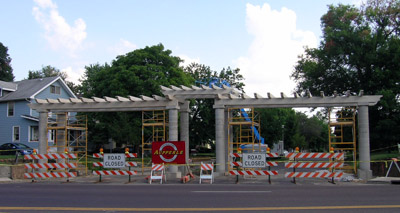 Bradley University first filed an Official Development Plan (ODP) in 1991 when the city created the N1 (Institutional) zoning designation. Since then, it has been amended four times, expanding their institutional boundaries each time, but the balance of the plan is still in effect. The largest addition was the St. James apartments east of campus.
Bradley University first filed an Official Development Plan (ODP) in 1991 when the city created the N1 (Institutional) zoning designation. Since then, it has been amended four times, expanding their institutional boundaries each time, but the balance of the plan is still in effect. The largest addition was the St. James apartments east of campus.
There are several things that are notable about the university’s ODP, which you can read in its entirety by clicking here (1.71M PDF).
NEIGHBORHOOD COLLABORATION
First, there was considerable collaboration between Bradley and the surrounding neighborhoods. An institutional planning committee was established through the West Bluff Council, which included representatives from Bradley-West (Arbor District), Moss-Bradley, and the Uplands neighborhoods, as well as representatives from Bradley University.
This process of collaboration was praised throughout the document, such as these statements:
The Committee frequently acknowledged that the University will not be as prominent an institution, nor will the Neighborhood maintain or improve its character, without cooperation and consideration of the needs of each other.
The University is furthermore committed to continue to exchange information and have open dialogue with Neighborhood representatives which will hopefully lead to further improvements toward resolving quality of life issues.
The document concluded by saying the process “reaffirmed the need for ongoing dialogue between the Neighborhoods and the University.” I wonder at what point the university decided to start stonewalling the neighbors until they’d acquired a critical mass of properties in the area where they wanted to expand?
PARKING UNDER ELMWOOD?
Another fascinating part of the document is their plan to solve Bradley’s long-term parking needs. They hired a consultant to assess the immediate and long-term needs and come up with solutions. The short term solution was to reconfigure existing lots (including widening Elmwood Ave.), lease space from owners of nearby lots, and better utilize on-street spaces within the institutional district. That added 305 spaces by the Fall of 1992. But the long-term solution was really interesting (emphasis mine):
Subject to further specific study and of course financing, the ultimate solution for additional parking supply appears to rest with construction of a parking structure. The proposed structure concept would lie underground from Main Street to Bradley Avenue under what is now Elmwood Avenue. The facility, which would be at least one level underground, would be accessible only from St. James (the campus entranceway). Surface parking would be retained.
In providing this solution, there is the related effect of improving parking to the central campus without encouraging additional neighborhood traffic. The plan would also allow the University to remove campus internal parking on the ODK circle (in front of Bradley Hall). Furthermore, the additional capacity of approximately 600 spaces could allow the University to vacate Fredonia Avenue for use as a pedestrian mall and also alleviate (or eliminate) the need for ancillary lot usage of the St . Mark and Newman Center lots.
Now that’s an ambitious plan, isn’t it? I wonder whatever became of it? I’m going to guess that cost was a major factor. In 1997, Bradley built an above-ground parking deck near the Global Communications Center instead. This provided an additional 690 parking spaces — almost a hundred more than the underground deck plan — and cost $4.5 million to construct.
LONG-TERM BOUNDARIES
The plan, and specifically the boundary of the N1 district, was designed to be “useful” for “at least 20-25 years.” That would be at least until 2011-2016. Now, I realize that no one in 1991 had a crystal ball, and that significant changes could have occurred between 1991 and 2006 that require the plan to be modified. But that begs the question: What has changed? Enrollment hasn’t dramatically increased.
The only thing that’s really changed is that the men’s basketball team gained nationwide recognition this year when they made it to the Sweet Sixteen. The university wants to take this opportunity to attract top-caliber athletes, and the way to do that is to have top-caliber training facilities. That means (to the university) replacing the aging Robertson Memorial Fieldhouse, which began life as a WWII airplane hangar.
But the replacement building will be larger and wipe out what little parking exists, thus the need for a new parking deck. The university wants to put that on the west side of Maplewood, where those big, historic homes stand now.
THE BOTTOM LINE
In the end, I think a lot of controversy and hard feelings could have been averted if the university would have continued their dialog with the neighborhoods instead of quietly buying up homes along Maplewood and keeping their plans a secret. They may have had to compromise — only use half of the frontage along Maplewood, for instance — but would have formed a stronger bond of trust with the surrounding neighbors.
The university’s plans, as far as I can discern them, are pretty modest as far as expansion goes. But they’ve created a climate of suspicion now that won’t be easily overcome. That’s unfortunate.


 Bradley University first filed an Official Development Plan (ODP) in 1991 when the city created the N1 (Institutional) zoning designation. Since then, it has been amended four times, expanding their institutional boundaries each time, but the balance of the plan is still in effect. The largest addition was the St. James apartments east of campus.
Bradley University first filed an Official Development Plan (ODP) in 1991 when the city created the N1 (Institutional) zoning designation. Since then, it has been amended four times, expanding their institutional boundaries each time, but the balance of the plan is still in effect. The largest addition was the St. James apartments east of campus.